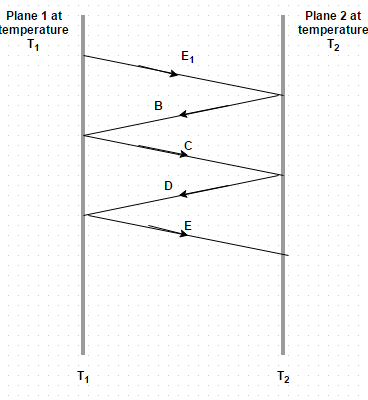Test: Heat Exchange Between Non Black Bodies - Chemical Engineering MCQ
10 Questions MCQ Test - Test: Heat Exchange Between Non Black Bodies
Consider radiant heat exchange between two non-black parallel surfaces. The surface 1 emits radiant energy E 1 which strikes the surface 2. Identify the correct option

A large plane, perfectly insulated on one face and maintained at a fixed temperature T 1 on the bare face, has an emissivity of 0.84 and loses 250 W/m2 when exposed to surroundings at nearly 0 K. The radiant heat loss from another plane of the same size is 125 W/m2 when bare face having emissivity 0.42 and is maintained at temperature T 2 is exposed to the same surroundings. Subsequently these two planes are brought together so that the parallel bare faces lie only 1 cm apart and the heat supply to each is so regulated that their respective temperatures T 1 and T 2 remains unchanged. Determine he net heat flux between the planes
Interchange factor for body 1 completely enclosed by body 2 (body 1 is large) is given by
A thermos flask has a double walled bottle and the space between the walls is evacuated so as to reduce the heat flow. The bottle surfaces are silver plated and the emissivity of each surface is 0.025. If the contents of the bottle are at 375 K, find the rate of heat loss from the thermos bottle to the ambient air at 300 K
A 250 mm by 250 mm ingot casting, 1.5 m high and at 1225 K temperature, is stripped from its mold. The casting is made to stand on end on the floor of a large foundry whose wall, floor and roof can be assumed to be at 300 K temperature. Make calculation for the rate of radiant heat interchange between the casting and the room. The casting material has an emissivity of 0.85
Interchange factor for infinitely long concentric cylinders is given by
What is the geometric factor for infinitely long concentric cylinders?
What is the geometric factor for concentric spheres?
The net heat interchange between non-black bodies at temperature T1 and T2 is given by
A thermos flask has a double walled bottle and the space between the walls is evacuated so as to reduce the heat flow. The bottle surfaces are silver plated and the emissivity of each surface is 0.025. If the contents of the bottle are at 375 K and temperature of ambient air is 300 K. What thickness of cork (k = 0.03 W/m degree) would be required if the same insulating effect is to be achieved by the use of cork?














